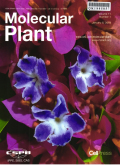- 钛学术文献服务平台 \
- 学术期刊 \
- 基础科学期刊 \
- 生物科学期刊 \
- 分子植物(英文版)期刊 \
Expanding base editing scope to near-PAMless with engineered CRISPR/Cas9 variants in plants
Expanding base editing scope to near-PAMless with engineered CRISPR/Cas9 variants in plants
基本信息来源于合作网站,原文需代理用户跳转至来源网站获取
摘要:
Dear Editor,
Base editors (BEs), including cytosine base editor (CBE) and adenine base editor (ABE), have been widely used to generate irreversible nucleotide substitution in plants and animals.However, their wide applications are largely hindered by the strict NG protospacer adjacent motif (PAM) sequences recognized by Streptococcus pyogenes Cas9 (SpCas9) and its engineered variants, such as SpCas9-NG and xCas9 (Hua et al., 2019;Ren et al.,2019;Wu et al., 2019;Zhong et al., 2019;Zhang et al., 2020).Most recently, it was reported that three new SpCas9 variants,SpCas9-NRRH, SpCas9-NRTH, and SpCas9-NRCH, could recognize non-G PAMs (NRNH, where R is A or G and H is A,C, or T) in human cells (Miller et al., 2020).Meanwhile, SPRY,another new SpCas9 variant, was developed to greatly expand the editing scope of BEs to nearly PAMless (Walton et al.,2020).In this study, we generated a series of efficient BE toolkits and almost achieved C-to-T mutation without PAM restriction except for NTG PAM, and largely expanded A-to-G mutation scope in stable transformed rice, providing a reference for application in other plants.

推荐文章
CRISPR/Cas9系统及其在作物育种中的应用
作物育种
基因编辑
CRISPR/Cas9系统
定点修饰
CRISPR/Cas9技术在大豆抗病虫育种中的应用前景
大豆病虫害
转基因育种
CRISPR/Cas9技术
基因编辑系统CRISPR/Cas9在作物基因工程育种中的应用
基因编辑技术
CRISPR/Cas9
基因工程育种
应用
基于优化sgRNA系统提高海岛棉CRISPR/Cas9基因组编辑功效的 研究
棉花
CRISPR/Cas9
编辑效率
脱靶效率
sgRNA类型
内容分析
关键词云
关键词热度
相关文献总数
(/次)
(/年)
引文网络
引文网络
二级参考文献 (175)
共引文献 (10)
参考文献 (6)
节点文献
引证文献 (0)
同被引文献 (0)
二级引证文献 (0)
1980(1)
- 参考文献(0)
- 二级参考文献(1)
1997(1)
- 参考文献(0)
- 二级参考文献(1)
2006(1)
- 参考文献(0)
- 二级参考文献(1)
2008(2)
- 参考文献(0)
- 二级参考文献(2)
2009(1)
- 参考文献(0)
- 二级参考文献(1)
2010(1)
- 参考文献(0)
- 二级参考文献(1)
2011(2)
- 参考文献(0)
- 二级参考文献(2)
2012(2)
- 参考文献(0)
- 二级参考文献(2)
2013(14)
- 参考文献(0)
- 二级参考文献(14)
2014(10)
- 参考文献(0)
- 二级参考文献(10)
2015(20)
- 参考文献(0)
- 二级参考文献(20)
2016(19)
- 参考文献(0)
- 二级参考文献(19)
2017(36)
- 参考文献(0)
- 二级参考文献(36)
2018(51)
- 参考文献(1)
- 二级参考文献(50)
2019(18)
- 参考文献(3)
- 二级参考文献(15)
2020(2)
- 参考文献(2)
- 二级参考文献(0)
2021(0)
- 参考文献(0)
- 二级参考文献(0)
- 引证文献(0)
- 二级引证文献(0)
引文网络交叉学科
相关学者/机构
期刊影响力
分子植物(英文版)
主办单位:
中科院上海生命科学研究院植物生理生态所
中国植物生理学会
出版周期:
月刊
ISSN:
1674-2052
CN:
31-2013/Q
开本:
出版地:
上海市岳阳路319号31B楼
邮发代号:
创刊时间:
语种:
eng
出版文献量(篇)
1996
总下载数(次)
1
总被引数(次)
17663
期刊文献
相关文献
推荐文献
- 期刊分类
- 期刊(年)
- 期刊(期)
- 期刊推荐
力学
化学
地球物理学
地质学
基础科学综合
大学学报
天文学
天文学、地球科学
数学
气象学
海洋学
物理学
生物学
生物科学
自然地理学和测绘学
自然科学总论
自然科学理论与方法
资源科学
非线性科学与系统科学
分子植物(英文版)2022
分子植物(英文版)2021
分子植物(英文版)2020
分子植物(英文版)2019
分子植物(英文版)2018
分子植物(英文版)2017
分子植物(英文版)2016
分子植物(英文版)2015
分子植物(英文版)2014
分子植物(英文版)2013
分子植物(英文版)2012
分子植物(英文版)2011
分子植物(英文版)2010
分子植物(英文版)2009
分子植物(英文版)2008
分子植物(英文版)2021年第8期
分子植物(英文版)2021年第7期
分子植物(英文版)2021年第6期
分子植物(英文版)2021年第5期
分子植物(英文版)2021年第4期
分子植物(英文版)2021年第3期
分子植物(英文版)2021年第2期
分子植物(英文版)2021年第1期

 免费查重
免费查重










